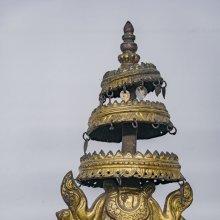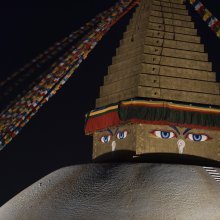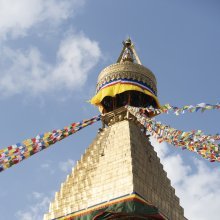Peak: 4 definitions
Introduction:
Peak means something in Hinduism, Sanskrit. If you want to know the exact meaning, history, etymology or English translation of this term then check out the descriptions on this page. Add your comment or reference to a book if you want to contribute to this summary article.
Images (photo gallery)
(+7 more images available)
In Hinduism
Natyashastra (theatrics and dramaturgy)
Source: Shodhganga: Elements of Art and Architecture in the Trtiyakhanda of the Visnudharmottarapurana (natya)The Peak (of a mountain) is denoted by the Sanskrit term Śīkhara, whereas Śīkharahasta refers to one of the twenty-two Single-hand Gestures (in Indian Dramas) (known as asaṃyuktahastas), according to the Viṣṇudharmottarapurāṇa, an ancient Sanskrit text which (being encyclopedic in nature) deals with a variety of cultural topics such as arts, architecture, music, grammar and astronomy.—The word śīkhara means the peak of a mountain. The Viṣṇudharmottarapurāṇa states that in śīkharahasta, the thumb is lifted in the position of a fist. This posture is used to hold rein, goad and bow. According to the Nāṭyaśāstra, apart from holding rein, goad and bow this posture is used to represent the acting of painting of lips and feet. According to the Nāṭyaśāstra, to show the raising up of hairs, this posture is adopted.

Natyashastra (नाट्यशास्त्र, nāṭyaśāstra) refers to both the ancient Indian tradition (shastra) of performing arts, (natya—theatrics, drama, dance, music), as well as the name of a Sanskrit work dealing with these subjects. It also teaches the rules for composing Dramatic plays (nataka), construction and performance of Theater, and Poetic works (kavya).
Vastushastra (architecture)
Source: Shodhganga: Elements of Art and Architecture in the Trtiyakhanda of the Visnudharmottarapurana (vastu)1) Peaks (of mountains) are considered desired sites for the construction of Temples, according to the Viṣṇudharmottarapurāṇa, an ancient Sanskrit text which (being encyclopedic in nature) deals with a variety of cultural topics such as arts, architecture, music, grammar and astronomy.—Selection of proper site is very necessary for any construction. It is the prime and first duty of the constructor or the proprietor to find out a perfect land which should possess the required qualities. [...] The sites like land outside a village, on the banks of rivers and lakes, forests, parks, peaks of mountains etc. are recommended as the desired sites for the construction of temples.
2) The Peak of the temple is denoted by the Sanskrit term Śikhara and in fact refers to the “topmost” part of the Hindu Temple.—Śikhara means the topmost part of a temple which can be said as a spherical roof rising like an inverted cup over a circular base. According to the Viṣṇudharmottarapurāṇa, the śikhara of the temple should be decorated with various figures and it should not be skull-shaped or pointed.

Vastushastra (वास्तुशास्त्र, vāstuśāstra) refers to the ancient Indian science (shastra) of architecture (vastu), dealing with topics such architecture, sculpture, town-building, fort building and various other constructions. Vastu also deals with the philosophy of the architectural relation with the cosmic universe.
Shilpashastra (iconography)
Source: Shodhganga: Elements of Art and Architecture in the Trtiyakhanda of the Visnudharmottarapurana (shilpa)Peaks should adorn Mountains in a painting, following the guidelines of ancient Indian Painting (citra), according to the Viṣṇudharmottarapurāṇa, an ancient Sanskrit text which (being encyclopedic in nature) deals with a variety of cultural topics such as arts, architecture, music, grammar and astronomy.—The Viṣṇudharmottarapurāṇa bears an elaborate description on the process of making the picture of some natural objects and phenomenon. According to the Viṣṇudharmottarapurāṇa, the picture of mountain should be adorned with plenty of rocks, peaks, metals, trees, streams and snakes. [...]. Thus, the Viṣṇudharmottarapurāṇa addresses various elements of nature, such as mountain peaks, since painting has much connection with time, mood and activity.

Shilpashastra (शिल्पशास्त्र, śilpaśāstra) represents the ancient Indian science (shastra) of creative arts (shilpa) such as sculpture, iconography and painting. Closely related to Vastushastra (architecture), they often share the same literature.
Yoga (school of philosophy)
Source: ORA: Amanaska (king of all yogas): A Critical Edition and Annotated Translation by Jason BirchThe Peaks of mountains are denoted by the Sanskrit term Śaila, according to the Yogatārāvalī: a short Yoga text of twenty-nine verses presenting Haṭhayoga as the means to Rājayoga (i.e., Samādhi).—Accordingly, while describing the no-mind state: “'[Practising] in caves on the peak (śaila) of Śrī Śaila [mountain], when will I succeed in dissolving my mind as prescribed [earlier and attain success] in Samādhi? When vines cover my body and when birds build nests in my ear”.

Yoga is originally considered a branch of Hindu philosophy (astika), but both ancient and modern Yoga combine the physical, mental and spiritual. Yoga teaches various physical techniques also known as āsanas (postures), used for various purposes (eg., meditation, contemplation, relaxation).
See also (Relevant definitions)
Ends with: Eagle Peak, Mountain peak.
Full-text (+772): Shikhara, Trikuta, Shringa, Trikakud, Kuta, Trishringa, Naubandhana, Shailakuta, Girishringa, Dasana, Kailasa, Hamsakuta, Trimukuta, Uttumgacuda, Adrishringa, Girisikhara, Phalika, Gijjhakuta, Koki, Jyotishka.
Relevant text
Search found 216 books and stories containing Peak; (plurals include: Peaks). You can also click to the full overview containing English textual excerpts. Below are direct links for the most relevant articles:
Puranic encyclopaedia (by Vettam Mani)
Humility < [April – June, 2001]
Confluence of past and present < [Jan. – Mar. 1991 & Apr. – Jun. 1991]
The Himalayas < [April – June, 1982]
Ramayana of Valmiki (by Hari Prasad Shastri)
Chapter 74 - Hanuman goes to the Mountain of Medicinal Herbs < [Book 6 - Yuddha-kanda]
Chapter 8 - Further Description of the Aerial Chariot Pushpaka < [Book 5 - Sundara-kanda]
Chapter 41 - Sugriva sends out other Monkeys to explore the Southern Region < [Book 4 - Kishkindha-kanda]
Banner of the Arahants (by Bhikkhu Khantipalo)
The Nilamata Purana (by Dr. Ved Kumari)
The Linga Purana (by J. L. Shastri)
Chapter 50 - The abodes of Devas (bhuvanavinyāsa) < [Section 1 - Uttarabhāga]
Chapter 51 - Various Continents < [Section 1 - Uttarabhāga]
Chapter 49 - Ilāvṛta sub-continent < [Section 1 - Uttarabhāga]
Related products






